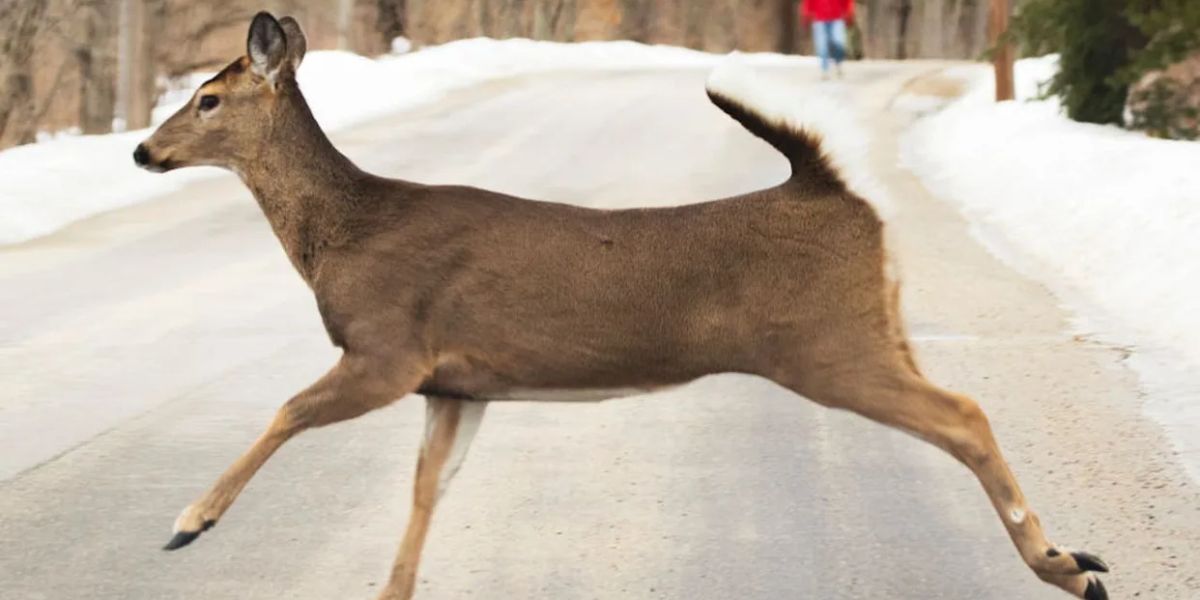Lansing, MI – Michigan drivers are heading into the riskiest time of year for deer-related crashes, with new state data showing just how dangerous the fall season can be on the roads. More than 56,000 deer crashes were recorded in the state last year, and officials warn November remains the peak month for these accidents.
Michigan’s earlier sunsets and the height of deer mating season both contribute to a sharp rise in collisions statewide. According to the latest statewide report, drivers should pay extra attention this month as crashes historically spike when visibility drops and animals become more active.
Deer Crash Trends Increasing in Late Fall
State crash records show that 2024 saw 56,697 deer-related crashes, with a significant share occurring from October through December. The highest concentration happened in November, when 10,017 collisions were reported. This aligns with the period when deer movement increases due to breeding patterns and reduced daylight.
Counties With the Highest Number of Crashes
Only one Metro Detroit county placed in the top 10 last year, highlighting how widespread the issue is across rural and suburban regions. Oakland County recorded 2,024 crashes, ranking just below Kent County.
The top counties for deer-related collisions included:
- Kent – 2,097
- Oakland – 2,024
- Jackson – 1,557
- Allegan – 1,517
- Genesee – 1,510
- Clinton – 1,447
- Ottawa – 1,433
- Lapeer – 1,426
- Washtenaw – 1,409
- Calhoun – 1,382
These counties represent a mix of rural landscapes and busy commuter routes, increasing the chances of vehicles crossing paths with wildlife.
Seasonal Risks and Driver Challenges
As fall progresses, shorter daylight hours limit visibility during key driving periods. Deer are most active at dawn and dusk, when many Michiganders are commuting. Dense wooded areas, farmland, and suburban edges are especially prone to deer movement.
Wildlife officials also note that Michigan’s deer population—estimated at around 2 million—makes encounters almost inevitable in certain regions. Even alert drivers may struggle to avoid sudden movements from animals darting into the road.
Safety Tips for Drivers During Peak Deer Season
AAA urges drivers to use extra caution throughout November. Among their top recommendations:
- Stay awake and alert, especially during early morning and evening hours.
- Always wear a seat belt.
- Slow down immediately if you spot one deer, as others are usually nearby.
- If a collision is unavoidable, brake firmly, keep the vehicle straight, and avoid swerving.
These precautions are designed to prevent both collisions and secondary crashes, which often occur when drivers jerk the wheel or leave their lane.
Safety Guidance for Motorcyclists
Motorcyclists face even higher risks in deer encounters due to lack of vehicle protection. AAA suggests:
- Reducing speed and watching road edges closely.
- Covering brakes to improve reaction time.
- Using high-beam headlights and extra lighting when conditions allow.
- Wearing full protective gear on every ride.
What to Do if a Deer Is in Your Path
Drivers are encouraged to remember the rule: never veer for deer. Swerving can cause a far more serious crash involving other vehicles or trees.
If a deer appears on the road:
- Keep the vehicle straight
- Brake immediately and firmly
- Maintain your lane and bring the vehicle to a controlled stop
Even at slower speeds, deer can behave unpredictably, making a steady reaction safer than sudden lane changes.
Steps to Take If You Hit a Deer
If a collision occurs, move your vehicle safely off the roadway and contact police and your insurance provider. Reporting the incident is important, especially if the animal remains on the road and poses a hazard to other drivers.
When exiting your vehicle:
- Take photos of the damage for insurance use
- Never approach the deer, whether alive or injured
Injured deer may respond aggressively and can pose serious risks to anyone who gets too close.
Staying Safe Through November
Michigan’s annual uptick in deer crashes is a predictable and preventable challenge for drivers. By slowing down, staying alert, and knowing what to do during a sudden encounter, motorists can reduce their risk during the state’s most active wildlife season.
Share your experiences in the comments below.






